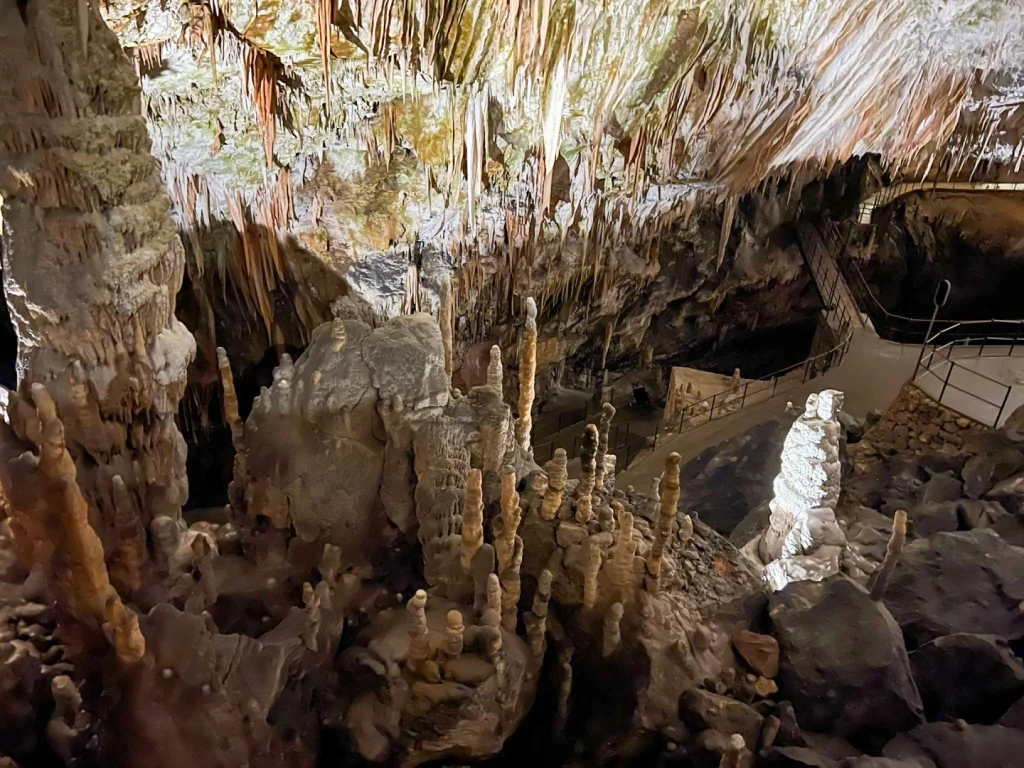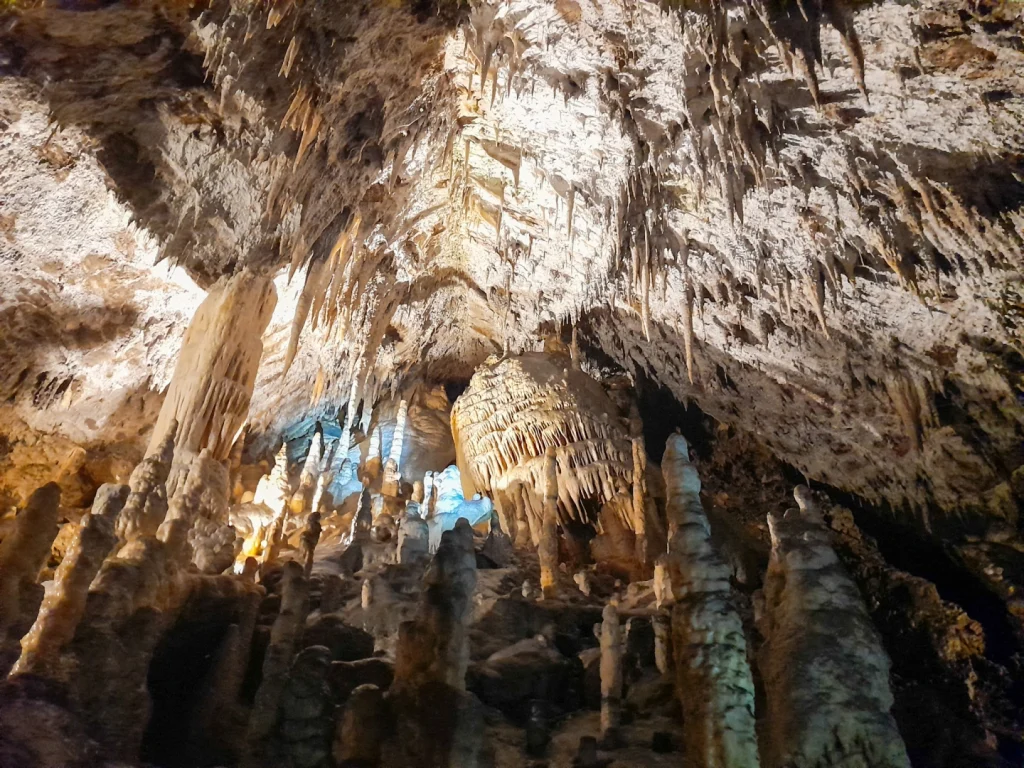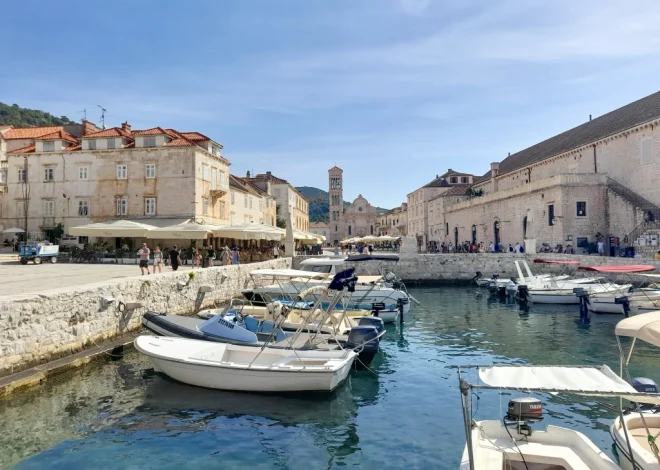
Visiting Postojna Cave & Predjama Castle from Ljubljana
Wow, wow, wow. This was one of my favourite European day trips ever! Whilst on a visit to Ljubljana in Slovenia, I was looking for things to do in the area and came across Postojna Caves and Predjama Castle about 5km apart. They looked beautiful, but I assumed they’d be heaving with people and the photos would have just been taken at forgiving angles. But oh my goodness, they were STUNNING.

History of the cave & castle
Postojna Cave is a 24,000 metre long cave carved out by the Pivka River over millions of years. It’s made of limestone, and each 1cm of growth takes around 100 years! The caves were officially discovered in the 1800s (although graffiti in the caves dates back to as early as the 1200s), and have been open as a tourist attraction since 1819!
In fact, the caves were even given electricity before Ljubljana itself was, way back in 1884, and it even had a train line installed in 1872 – well ahead of its time. Today, the train is electric and only 5km of the cave is open to the public. But 5km is more than enough to explore one of the most amazing sites in the country.
Predjama castle is built in to the cave network, about 5km away from Postojna cave. It was first built in the 1200s, and is legendary for its 15th century resident, Erasmus Lueg. Erasmus came into conflict with the Habsburgs when he killed the commander of the imperial army and he fled from the vengeance of the Holy Roman Emperor of the time, Frederick III, by going to Predjama. He was able to withstand a siege for over a year, by escaping through the cave pathways behind the castle to get food. Erasmus was eventually betrayed by one of his men and shot from a cannon whilst on the loo!
Getting to the cave & castle (incl. prices)
I recommend visiting the caves first in the early morning. This is because they are the biggest tourist attraction in the area and you have to visit on a tour which runs every 2 hours in low season (November to March), every hour in shoulder season (April, May, June, September, October) and every half hour in the peak season (July & August). We visited in the low season so got there for the first tour of the day and there were still about 100 or so people on the same tour as us. I dread to think what it’s like in summer and I highly recommend buying tickets in advance.
The easiest way to get to the caves from Ljubljana is to drive, which takes about 30 minutes. There is ample parking space. Entrance to the cave costs EUR28.50, or EUR40.90 including the castle as well.
Alternatively, you could book a day trip picking you up from your Ljubljana hotel, and I highly recommend Slovenia To Do. A day trip (combining the caves and castle) will cost you somewhere between EUR70-100, depending on provider.
After the caves, head to the castle – which was almost empty on our visit save for about 5 other people. Again the easiest way is to drive or to have combined it on a pre-arranged day trip. A shuttle also runs between the two sites between July and early September, or the ticket office at the caves can book you a taxi which will cost around EUR10.
Postojna cave visit
Arriving at the entrance to the cave, you are split in to different languages as each time slot runs in Slovenian, German, Italian and English. Each group is then taken to board a train which runs through the caves for 3.5km.
The train ride was so much fun, and we were so lucky as we managed to be right at the front of the train! Please do wear warm clothes though as it’s quite cold down there and the train goes quite quickly so the resulting wind makes it even chillier! The train then pulls in to the main chamber with the most incredible views.
After disembarking the train, you then also walk through the cave for 1.5km with a guide. This takes around 1hr and is just incredible. To avoid lots of people in my photos I made sure to be right up front to get the views out in to the caves uninterrupted and was very glad I did.
I can’t even begin to tell you how insanely beautiful and unique the cave was. The photos scarcely do it justice and the size and scale of the cave was amazing. I just kept saying wow around every corner and at all the formations. There were stalactites, stalagmites, curtains, pure limestone formations, red formations where the limestone has mixed with iron, and white formations where its mixed with calcium. There were strange shapes and beautiful colours, there were funny textures (which you’re not allowed to touch) and a constant drip, drip of water.
After the walk, we boarded the train again and whizzed back through the darkness to the entrance. Even as I type this I keep saying wow to myself. I was totally taken aback by nature’s ability to create this wonderful place and I am so glad I visited. After that it was time to head on to Predjama Castle, but this truly was a highlight of my visit to Slovenia.

Predjama castle visit
You can explore the castle at your own leisure, using an audio guide which has around 45 minutes worth of content. It’s a really unique castle, with half of it being building and half of it being cave!
You are also able to head in to the mouth of the cave behind the building and see how big and deep it was. Though be careful, the steps are super slippy and steep so it’s very easy to slip and fall. Sensible shoes are essential!
Today the castle itself is preserved in the medieval style dating back to the structure of 1567, which was the last to be built after the previous versions were destroyed by earthquakes. The castle was in private hands and passed to the Windischgratz family in 1846, who remained its owners until the end of WW2, when it was confiscated and nationalized by the Yugoslav Communist authorities and turned in to a museum. And, after enjoying some final views out across the valley before leaving it was time to head back to Ljubljana – what a day!



